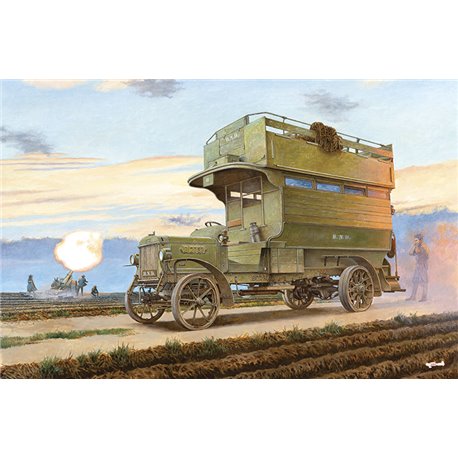No products
Product successfully added to your shopping cart
There are 0 items in your cart. There is 1 item in your cart.
More info
WWI Type B Omnibus Old Bill
2 schemes :
- D218/"White 8", British Expeditionary forces, Western Front, France, 1917
- British Expeditionary forces, Western Front, France, end 1918
HISTORY
At the beginning of the 20th century, at a time when Great Britain was the world's preeminent superpower, and its capital London was the hub of the world's political and economic activity; due to the rapid pace of urbanization of large cities, the challenge of transporting groups of people with a completely new means of transport had arisen, as traditional horse-drawn carriages (the so-called "cabby") could no longer cope with such a task in its entirety. Thus, a fundamentally new kind of transport appeared - the "omnibus", or bus in the modern form of the word. Already in 1910, the LGOC (London General Omnibus Company) was established, soon occupying a dominant position in the field of transportation. Already in 1911, at his request, designer Frank Searle sketched out the design of a vehicle, which for many years was to become the "business card" of the city on the Thames. It was a twostory bus with stairs between the floors, which enabled a significant reduction in the size of the vehicle while still able to transport a large group of people. The new bus was named "Type B" and was exploited with significant commercial success in subsequent years.
The First World War, which broke out in the summer of 1914, immediately gained momentum, forcing a search for a means to rapidly move large groups of soldiers as close as possible to the points of contact with the enemy. The military leadership immediately became interested in the possibility of using omnibuses, and soon the first Type B vehicles had been delivered into military service. In total, from October 1914 to March 1915, 300 Type B buses were requisitioned, which were forced to exchange the streets of London for the shell-cratered terrain of France. Former civilian drivers from London were now obliged to become military drivers, and the work of the buses, which consisted in the rapid transfer of groups of soldiers to the front, was quite dangerous given the possibility of shelling by the enemy, and therefore the carriage of troops was carried out mainly at night.
The first buses to hit the Western Front were still in their civilian colors of bright red, and plastered with the advertisements of London newspapers or large stores, but soon they, like other military vehicles, had to wear uniform - all their surfaces were repainted in the protective color of the Khaki, the windshield was removed because it could not withstand bad roads and quickly shattered, the side windows were replaced with wooden boards, and a canvas covering was fitted to the open second floor. An omnibus could carry 34 passengers (16 on the first level and 18 above), but its capacity for the purposes of military use, of soldiers equipped with full ammunition, was only 24 to a bus; however that figure was a great improvement on what was possible with horse-drawn carts.
One of the first operational uses of the Type B was for the transfer of troops to the town of Ypres, where on October 21, 1914, one of the most significant battles of the Great War took place. In the next four years, omnibuses were used with unending intensity, sometimes seven days a week. Apart from the transport of ersonnel, they carried ammunition, food and medicine to the front line, and in the first postwar months after the signing of the Truce, they went back to permanent civilian work. In the spring of 1918, when Germany attempted a massive counteroffensive along the line of the Western Front, Type B buses, along with other types of omnibuses, carried at least 211 000 soldiers, with the total mileage covered by them amounting to over 1 million kilometers.
After the end of the First World War, a large number of omnibuses returned to their home town, and the LGOC redeemed them for the second time from the army, and once again they began to dominate the streets of London as the main vehicle of public transportation. One of the Omnibuses, which received the semi-official name"Ole Bill" (in honor of the cartoon character of the British soldier created by the artist Bruce Bairnsfather), was on February 14, 1920, inspected by His Majesty George V during a demonstration of the techniques of war, and in subsequent years it took part in numerous memorial parades for anniversaries of the Great War, and in 1970 it was transferred to the Imperial War Museum in London, where it is still preserved as one of the most significant artifacts of the "War, which was to end all wars".






